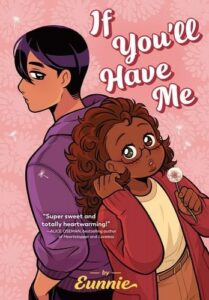If You’ll Have Me is a very tender, very human story about two women with their own baggage who realize that sharing the burden often makes it easier to bear.
Both Momo and PG have been unlucky in love, and their first meet-awkward hardly seems poised to change that. But as they spend more time together, their feelings and blush-strokes both begin to deepen.
It was refreshing to read a sapphic romance set in a college setting. As I get older, I’ve found myself gravitating towards stories with women who have come through the gauntlet of adolescence only to find they still have a lot of learning and growing to still do. I’ve also met more women who didn’t have their first relationships in high school, in undergrad, or until they started working. It is nice to see those stories get told, too—especially with such lovely artwork! Every panel, even the bluest, is so suffused with warmth. The color palette and linework are probably some of my favorites in recent memory. While the aesthetic influences are pretty clear, the art style also has its own unique signifiers.
I appreciated how the importance of communication was explored in this story. The different inter-character relationships are well written, and handled with warmth and sincerity while not shying away from the conflicts that can arise from good intentions. We see how Momo and PG interact with friends, family, and how those dynamics shape their interactions with each other. We get to know their support networks, their social habits, and this makes their private moments all that much more textured.
One of my favorite aspects of this story was the emphasis on showing rather than telling, which comics as a combined visual and written medium are uniquely suited to. Some of the conversations are just as shaped by what is not said as what is, and the panels where we see PG with her family do this beautifully. There is a weight behind their words, whole histories being considered in the spaces between the panels.

